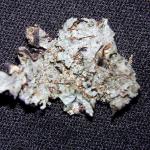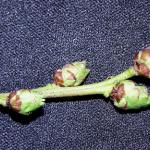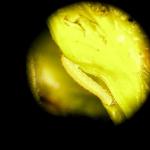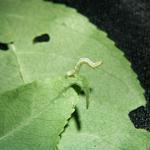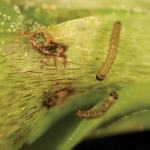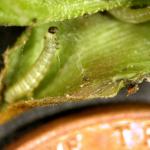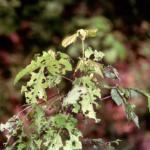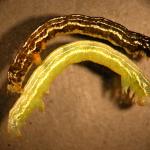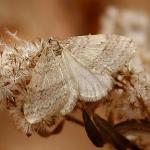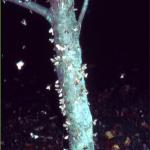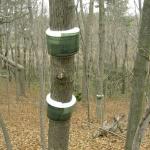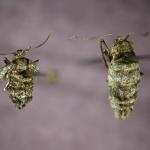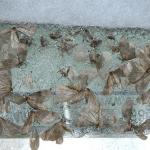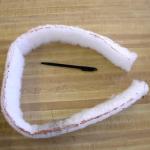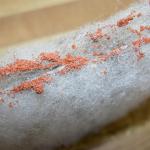Winter Moth Identification & Management
Pest: Operophtera brumata
Order: Lepidoptera
Family: Geometridae
Host Plants:
While oak, maple, and apple are preferred hosts, many other deciduous plants are susceptible to damage from winter moth caterpillars. These include but are not limited to: cherry, basswood, ash, white elm, crabapple, and blueberry. Winter moth caterpillars may also drop or ‘balloon’ onto nearby plants like roses, herbaceous perennials, annuals, etc. that may be found near or beneath infested trees. Winter moth caterpillars are not usually found feeding on evergreens or broad-leaved evergreens, although they have been found on certain spruces such as Sitka spruce (Europe), and heathers (Scotland). Partial defoliation can be the norm for this species. Damage to blueberry and apple crops is especially severe as the reproductive parts responsible for fruit can be destroyed before buds open fully.
History:
Winter moth is a non-native insect that was identified in Massachusetts in 2003, through the collaborative efforts of Deborah Swanson, Horticulturist, UMass Extension/Plymouth County Extension (retired), Hanson MA, the late Robert Childs, Entomologist, UMass Extension, Dr. Joseph Elkinton, Entomologist, UMass, Amherst, MA, George Boettner, Lab Manager in the Dept. of Environmental Conservation at UMass, Amherst, MA, Dr. David Wagner, Entomologist, UConn, Storrs, CT and Richard Hoebeke at Cornell University, Ithaca, NY in 2003.
Winter moth was initially introduced from Europe to North America via Nova Scotia in the 1930’s, where in the 1950’s it became a serious pest in parts of eastern Canada (Nova Scotia and Prince Edward Island). It was then introduced separately to western Canada around 1970, where it became a problem in Vancouver, British Columbia. In the1950’s, Winter Moth was also found in the western United States of Oregon and Washington, where it warranted control measures primarily in commercial blueberries. Outside of Oregon and Washington states, prior to its discovery and identification in Massachusetts in 2003, winter moth was not known to be a significant pest in any state in the United States. See Winter Moth in Massachusetts: History and Biological Control for more information.
Life cycle:
Moths (the adult stage of winter moth) emerge from pupae in the soil usually in mid-late November (usually before Thanksgiving) and may be active into January, whenever the air temperatures are mild (typically when above freezing). The small (0.79-0.98 inch wingspan) male moths are light brown to tan in color and all four wings are edged with small elongate scales that give the hind margins a slightly hairy or fringed appearance. The male moths are strongly attracted to lights and can often be found flying around outdoor lamps or holiday lights. The female (0.31 inch) is gray, almost wingless (brachypterous) and, therefore, cannot fly. She emits a sex pheromone that often attracts clouds of male moths. Females are usually found at the base of trees or scurrying up tree trunks, but can be found almost anywhere.
After mating, the female deposits loose eggs on bark, in bark crevices, under bark scales, on lichen, etc. Each winter moth female may produce 150-350 tiny eggs, which are very difficult to see. The adult moths then die and the eggs over-winter. Eggs are green at first, but turn red-orange soon thereafter. In March, prior to hatching, the eggs turn a bright blue and then a very dark blue-black just before hatching. Eggs hatch when temperatures average around 55º F. It is believed that egg hatch in Massachusetts occurs when 20–50 Growing Degree Days1(base 50º F) have accumulated, which can be anywhere from late March into early-mid April, depending on the year and the location. (The Elkinton lab at UMass, uses a base 40º F when completing Growing Degree Day calculations for this insect and suggests that hatch occurs between 177 and 243 GDD (base 40°F).2)
In most years, egg hatch occurs just at, or right before, bud break of most of the host plants and delayed bud opening due to cool weather can lead to caterpillar death. The newly hatched caterpillars crawl up tree trunks and wriggle between bud scales of newly swelling buds of such hosts as: maple, oak, ash, apple, crabapple, blueberry, and cherry, etc. and begin feeding. Winter moth caterpillars cannot chew their way through closed bud scales, but as the bud scales open, the caterpillars can scrape away at the soft leaf tissue below, producing bullet-hole like damage to the leaf, even before it fully expands. The young larvae also produce strands of silk, which make them air buoyant and this larval dispersal method is known as "ballooning" (like bungee jumping, but not staying tethered to the point of origin). In certain situations, given topography and wind patterns, ballooning winter moth caterpillars can arrive in areas where they have not been expected to be a problem.
The caterpillars feed in both flower and foliar buds and, once a bud has been devoured from within, the caterpillar will migrate to other buds and repeat the process. Destruction of the flower buds leads to greatly diminished harvest on fruit crops such as apple and blueberry. After buds open, the small caterpillars can be found within the tight clusters of new leaves and flowers during the day. During cool springs, if weather hinders leaf expansion but bud scales have begun opening, the winter moth caterpillar can cause high levels of foliar injury as they are protected from insecticides while inside the buds. Winter moth caterpillars often leave foliar clusters to become free feeders at night. Older larvae feed in expanding leaf clusters and are capable of defoliating trees and other plants, when abundant. At maturity, the caterpillars will be approximately one-inch-long, whereupon they drop to the soil for pupation. Pupation occurs in late May/early June depending on the geographic location. Areas including Cape Cod are often a week or two behind inland locations.
Description:
Winter moth caterpillars are very tiny when newly hatched, less than the size of an eyelash and they are blackish in color at that time. As they feed and increase in size, they are pale green with a faint white longitudinal stripe running down both sides of the body. They are "loopers" or "inchworms" and have just two pairs of prolegs. Winter moth caterpillars are often found in association with both the fall and spring cankerworms, as well as Bruce spanworm (Operophtera bruceata), which are very similar in appearance and have similar feeding patterns to that of the winter moth caterpillar. Fall cankerworm caterpillars have “2 and ½” pairs of prolegs: two pairs of the prolegs are longer than the third, much shorter pair which is counted as number 3 when starting your count from the rear end of the caterpillar. Bruce spanworm is native to the Northeast and is rarely a problem. However, the males of this species are attracted to the pheromone used in winter moth traps and thus create a challenge for researchers to discern the difference between the males captured in these traps given their remarkably similar appearance.
Management:
Treatment for the Eggs:
Horticultural oils work by suffocation and can be effective on insect eggs. Oils must cover the target organism at the time of application or no insecticidal effects will result.
Given that many winter moth eggs are exposed on the bark, the potential to manage them with a horticultural oil spray exists, however, it is probably not practical for ornamental landscape trees, as eggs that are protectively hidden within crevices and under lichen will not be covered by the spray and killed. In years of heavy winter moth pressure, oil sprays will most likely only achieve limited results; eggs are deposited virtually everywhere on trees and shrubs and new caterpillars will quickly migrate from untreated areas to the oil-treated plants via ballooning.
Dormant oil spray applications are mostly recommended for blueberry and apple growers and not so much for landscape operations where protecting the flower buds is not as essential as it is for commercial or home fruit growers. Some growers add a chemical companion, such as spinosad, to the oil spray to reach newly hatched caterpillars whose eggs were not covered by the oil. However, it is extremely important to know what can and cannot be mixed with oils and then applied to specific plants. This method is best left to the professional licensed applicator and not the homeowner as mixing compounds that should not be used together can cause serious injury to plants, the environment, and the applicator. Always check to be certain that any two pesticides are compatible for tank mixing by reading the label or consulting with the manufacturer of the pesticide(s).
Typically, dormant oil sprays are applied in the very late winter or very early spring depending on temperatures and host plant phenology. When applying oil sprays, it is prudent to have temperatures above 45°F and to avoid applying oil when temperatures may dip below freezing for 24-48 hours after application. Temperatures below this threshold greatly increase the risk of causing injury to the plant (phytotoxicity). Certain weather conditions, such as when it is cool and cloudy, can also delay drying time and enhance the potential for injury.
Oil sprays are sometimes applied in the fall to manage certain insects, but it is of no use for winter moth given that the eggs do not appear until very late fall and into the early winter.
Treatment for Free-Feeding Caterpillars:
In spring (early – mid-April), monitor expanding tree buds and developing leaves for winter moth caterpillars on susceptible trees and manage early, if present. Managing winter moth caterpillars when they are small will often result in reduced foliar damage. Winter moth caterpillars are active from April until late May or early June, whereupon they drop to the soil and almost immediately spin a cocoon and pupate.
(see Fig_6 through 9) Once the buds open, the larvae are known as "free-feeders" given that they are now on the foliage and free to move readily from one area to another. As “free feeders”, winter moth caterpillars are exposed and very treatable with a variety of products. Particularly with ornamental plants, it is best to wait until leaves have fully expanded before applying the below active ingredients. (As mentioned earlier, in crops such as blueberry and apple, this is not the case.)
1. Spinosad: This active ingredient is derived from a bacterium that is subjected to a specific fermentation process to develop the active ingredient(s) for the insecticide commonly known as spinosad. It works on the insect nervous system in a novel manner and can be effective as a contact spray as well as by ingestion.
A. Spinosad is a biorational insecticide and can also be referred to as a microbial pesticide. Biorational insecticides are materials that are relatively non-toxic to people with few environmental side effects, particularly when compared to chemical insecticides discussed below.
B. Spinosad products work well on caterpillars of all ages, even caterpillars known as sawflies, which are the larval stage of certain wasps in the order Hymenoptera.
C. Although fairly safe by not harming parasites and predators, the label does warn that spinosad can be “highly toxic” to bees at the actual time of application. Once the spray has dried, however, the toxicity to foraging bees is much reduced. An example would be to not spray for winter moth when crabapples, or other flowering trees, are in bloom and bees are foraging.
2. Bacillus thuringiensis (kurstaki), also commonly known as B.t.k: This product is a bacterium that is specific to lepidopteran larvae (butterfly and moth). It must be ingested to be effective. Once inside the gut, this bacterium becomes activated and multiplies. By going through a somewhat complicated biological process, this product will eventually form toxins that become lethal to the caterpillar. A few notes about its use:
A. B.t.k. works best on the younger instar stages of caterpillars; older ones are much less affected.
B. This product fits well into any IPM program, in that it does not impact the environment, harm the applicator nor does it affect beneficial organisms such as predators and parasitoids, when used as directed.
C. If applied while the buds are still expanding, any new foliage that emerges in the days after application of this product will not be protected.
D. Caterpillars that ingest B.t.k. will stop feeding almost immediately however they may not die for 1-3 days. It is often disconcerting to still see live caterpillars days after treatment but even though they may be moving, they are not feeding.
E. Although some may be concerned about B.t.k's effect on native Lepidopteran species, it usually poses a limited negative effect given the relatively small areas being treated (e.g. individual trees and not entire forests).
3. Chemical Insecticides: Although many of the organophosphate (e.g. malathion, acephate) and carbamate (e.g. carbaryl,) insecticides are now unavailable or limited in use, a few still exist. Mostly, when considering the chemical insecticide option (over a biorational or microbial insecticide) the more conservative chemical choices now are the pyrethroids, which can range from toxic to highly toxic (depending on the product) to bees and other insects, even after they dry. Do not spray plants when they are in bloom. In general, they would be applied at egg hatch, although timing is difficult. They are mostly used against the free-feeding caterpillars once the buds have opened. In general, pyrethroids have a "knock-down” effect by killing the target organism quickly. They then break down into inert ingredients, sometimes within a matter of days. This, however, varies depending on the specific pyrethroid product used and the conditions that it is subjected to after application (e.g. weather, temperature, added stickers, etc.) and some can persist for longer periods of time in the environment. In general, these chemical products tend to be much harsher on the beneficial organisms and should be used thoughtfully. Some pyrethroid products are restricted use. Always consult your local supplier and always read, understand, and follow all label directions for pesticide products.
4. Insect Growth Regulators: Also known as IGR’s, active ingredients such as tebufenozide mimic the hormone ecdysone, which is commonly referred to as "the molting hormone" and ingestion of this product prevents the caterpillar from molting (shedding its exoskeleton and forming another in order to grow) and it dies. Tebufenozide is only effective against lepidopteran caterpillars and will not work on sawfly caterpillars. Tebufenozide is considered to be a very effective tool for the IPM approach to managing winter moth caterpillar, however it still has environmental implications including but not limited to toxicity to aquatic organisms and ground water protection concerns as it has properties and characteristics similar to chemicals detected in ground water. For all insecticidal products, always read, understand, and follow label instructions.
A guideline of not applying insecticides to flowering plants is important to follow when considering using chemicals that are toxic to pollinators. Other actions an applicator can take to preserve pollinators can also include the timing of application (after bloom or times of day when pollinators are less likely to be active) and choosing least toxic active ingredients with shorter residual action. Certain product formulations may be more likely to impact pollinators (dusts, wettable powders, and microencapsulated products may cling more readily to the bodies of foraging bees). Treating at temperatures where bees are less-likely to be foraging (for many, that is below 55°F) or cooler times of day can be best for avoiding interaction with these beneficial insects.
With any chemical or biorational management option that kills winter moth caterpillars, there is also a chance of killing Cyzenis albicans, which may be parasitizing those caterpillars if management is implemented within biocontrol release sites and the surrounding areas where Cyzenis albicans is currently spreading on its own. Management should focus on killing eggs of winter moth (dormant oil sprays) where practical (such as in blueberry crops or very small landscape plants) or limit sprays to biorationals such that can target early instar (younger) caterpillars where possible, to prevent killing C. albicans larva in the later instar (older) caterpillars and pupae. However, if a smaller number of host plants are treated, as can be typical in a landscaped situation, the impact to C. albicans may be low and this biological control organism will still have winter moth available in nearby forested areas to utilize during its lifecycle.
Treatment for Winter Moth Pupae in the Soil:
There are virtually no controls for this pest in this life stage other than natural predation by such organisms as ground beetles, small mammal predators (especially shrews), and wasp predators.
Winter moth caterpillars drop from their hosts to the soil to pupate around late May/early June in Massachusetts and remain in the soil until the adults emerge roughly around mid-November. Anyone doing fall transplants, renovations, or cleaning up garden beds near winter moth host plants that have had issues with this insect should be aware of the risks of accidentally transporting winter moth pupae that may be present within these soils.
Treatment for Adult Winter Moths:
There are no control options for the adult stages of these moths. They do not feed in this life stage.
Banding Trees:
Some products are available and are advertised that the bands act as a barrier to climbing caterpillars, and/or for the climbing adult female moths in late fall to early winter. This method is known as "tree banding". The products for tree banding are generally heavyweight paper or plastic strips that are covered with a sticky substance that snare climbing caterpillars or female moths. However, field observations do not necessarily support the effectiveness of tree bands for reducing winter moth populations when in high numbers and they are therefore not recommended for that purpose.
Using Trees Bands to Monitor Egg Hatch for Managing Winter Moth Caterpillars:
Trees bands, however, have inadvertently been found to be useful for monitoring winter moth egg hatch in the spring. In late October, place a band around the trunk of an oak, maple, or apple tree that has a history of winter moth damage. (Place, or wedge, cotton or polyester fiberfill under the band to prevent the small female moths from going under the band and continuing their climb up the tree.)During peak winter moth population years, individual sticky bands may fill up with adult moths within an hour. In some cases, it has been witnessed that female winter moths, upon approaching the barrier bands, often lay their eggs on the tree trunks just below the barrier and/or crawl over or under the barrier and lay their eggs just above. The eggs are often laid in a circle above and below the band and can be seen with a magnifying lens.
To monitor for winter moth egg hatch in late-March to early to mid-April, go out and look around the bark directly above or below the bands to check if the eggs have changed color, or are about to hatch, using a hand lens or other magnification. Eggs that are still orange-red are not yet ready to hatch, whereas those that are turning blue are very close to hatching. The observation of the timing of egg hatch may aid in the planning of chemical management options, particularly in crops such as blueberry and apple, where the insecticides must be applied prior to winter moth caterpillars wriggling their way into flower buds to feed.
Conclusion:
Winter moth is a very serious insect pest. Over the past 15+ years it has caused significant damage to and the decline of many trees, in eastern MA, especially southeastern MA and on the North Shore. Many deciduous trees (primarily oak) are displaying signs of serious decline given the multiple consecutive years of defoliation by winter moth, frequently in combination with forest tent caterpillar and gypsy moth.
Within the past several years, many trees (mostly oak) have died in southeastern Massachusetts from the stress of this defoliation coupled with drought and other factors. Several years of defoliation often weakens trees to the point where secondary agents (sometimes known as 'weak invaders') can overcome what is left of a tree's natural defenses (due to repeated defoliation) and kill the tree. Such secondary invaders include: wood borers, bark beetles, Armillaria (shoestring root rots) and others.
Research in Canada has shown that four consecutive years of partial defoliation of deciduous hosts can lead to branch mortality while complete defoliation in each of those years leads to tree mortality. In certain regions of Nova Scotia, this pest was responsible for 40% red oak mortality in forested stands in the 1950s before biological control by Cyzenis albicans became widespread in the early 1960s. Since that time, winter moth has been mostly a non-pest in Nova Scotia.
Additional information:
1Growing degree day information is available in the Landscape Message for areas throughout Massachusetts, using a base 50ºF. For more information on how to calculate growing degree days, please visit this fact sheet.
2The Elkinton lab at UMass uses a base 40º F when completing Growing Degree Day calculations for this insect and suggests that hatch occurs between 177 and 243 GDD (base 40°F, January 1 start date, double sine method). Resources such as uspest.org will allow you to manipulate how GDD’s are calculated, including using a base 40ºF and different mathematical models. The reason for using Base 40 is that 40ºF is very close to the minimum temperature for winter moth development and considerable GDD accumulation occurs between 40-50ºF. Predicting hatch with GDD is imperfect for this insect, however. Research in the Elkinton lab and in Europe has shown that later springs with older eggs require fewer GDD to hatch.
Winter Moth in Massachusetts: History and Biological Control: fact sheet for information on the history of winter moth in Massachusetts and Dr. Joseph Elkinton’s (of UMass) research on the biological control of this insect.
Written by: The late Robert Childs, Entomologist, UMass Extension, Deborah Swanson, Horticulturist, Plymouth County Extension (retired), and Joseph Elkinton, Professor in the Department of Environmental Conservation at UMass Amherst with Recent Updates from Tawny Simisky, Extension Entomologist, UMass Extension Landscape, Nursery, & Urban Forestry Program, Deborah Swanson, Joseph Elkinton, and George Boettner, Lab Manager in the Dept. of Environmental Conservation at UMass Amherst.
